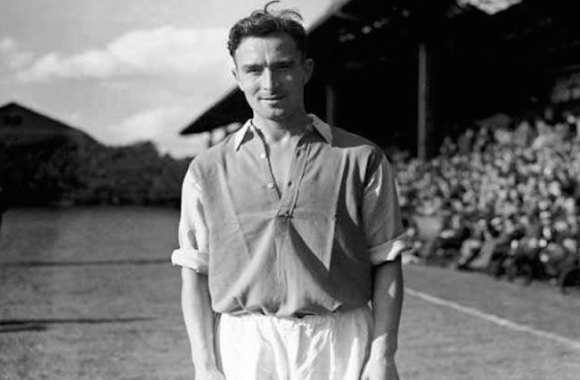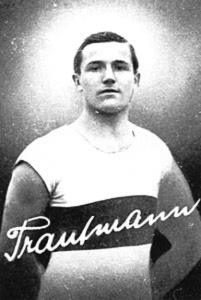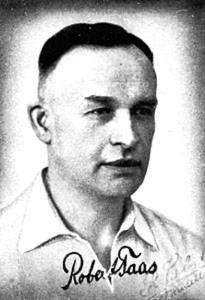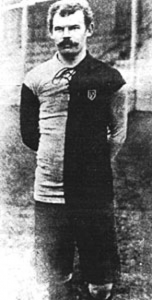CURIOUS FACTS ABOUT NATIONAL AND INTERNATIONAL PLAYERS (1910)
Picture : Andrew Ducat, international football and cricket player for England !
Interesting and curious facts about full internationals and national players (1910)
————————————————————————————————————–by IFFHS—
1910
Andrew Ducat, born in Brixton on February 16, 1886, attended the Brewery Road School and Compton House School in Southend, where he also learned to play football. He played for Westcliff Athletic and Southend Athletic before joining Woolwich Arsenal FC (London) in February 1905. He played for Aston Villa from 1912 to 1921 and then three years for Fulham FC, which he managed for another two. “Andy” Ducat started out as a centre forward, but eventually found his ideal position to be wing half-back, where he could put his tactical skills and almost academic game to better use. From 1910 to 1921 he played for England six times, and in 1920 won the English Cup with the “Villans”. However, “Andy” Ducat also was a cricket international, and played cricket for Surrey from 1906 to 1931. He scored more than 23,000 runs all together. He later coached the Eton cricket team and worked as a newsman. He died during a cricket match on July 23, 1942.
——
In 1910 France lost all three of their full “A” internationals, thus making ten consecutive international defeats, and by a good margin. When France met the England amateurs (1:10) in Brighton on April 16, 1910, outside left Auguste Tousset(Étoile des Deux Lacs) was a last-minute replacement for Joseph Delvecchio. The previous day, Tousset – completely unprepared – had been present at the railway station entirely by chance, where he travelled with the team to England when it turned out that Delvecchio would be unable to make it. As it was, Tousset even scored the consolation goal.
——
Harold Thomas William Hardingewas born in Greenwich on February 25, 1886. He played for Maidstone United before joining Sheffield United in 1905, where he needed two years to make the league team, but then was a regular until 1913. The last side he played for was the London club Woolwich Arsenal FC (1913-1921), which in 1914 was renamed Arsenal FC and from the 1919/20 season belonged to the first division. The inside forward was an individualist on the field, but also quite good at outwitting the opponents‘ defence. He only played once for England, in 1910. “Harry” Hardinge also was a cricket international, and played cricket for Kent from 1902 to 1933, scoring over 33,000 runs. By profession he was an employee of the sports goods retailer John Wisden, doing occasional stints as a coach in the USA and in Spain. He died on May 8, 1965.
——
Wilhelm Trautmannwas born in Mannheim on December 6, 1888, and already in his youth was one of the football pioneers in his home town. He played for Mannheimer FC Victoria 1897 until 1911, when the club merged with local rivals FG to become Verein für Rasenspiele (VfR) Mannheim. Wilhelm Trautmann, the first German international from Mannheim, made his international début as centre-half in Basel on April 3, 1910, against Switzerland (3:2). This was also his only full “A” international. Originally, he had been a track-and-field athlete, and had had regional success at multi-discipline events. He was gifted with a powerful shot and enlivened the game on the football pitch. He joined the army in 1914 and returned from World War I seriously injured, unable to continue his sporting career. He went into hog wholesale and died on July 24, 1969.
——
Wilhelm Trautmann Foto: Kicker-Sportmagazin
Willy Fick, born in Lurup (Pinneberg) on February 17, 1891, started playing football at FV Holstein Kiel, a club which had emerged from FC Holstein in 1908. On April 17, 1910, the inside left played for the “Störche” [Storks] at the finals of the German championship (4:1 FC Preussen, Berlin). One week later he made his international début in Arnhem (2:4 Netherlands), and following week played in the semi-finals of the German championship (6:0 FC Tasmania 1900, Rixdorf). Willy Fick scored in all three matches. When in 1911 his club contested the German championship again, his younger brother Hugo Fick played on outside right while Willy was injured and unable to play. In 1912 the “Störche” finally won the German championship, with Hugo and Willy Fick playing as inside right and left. A few months later Willy Fick fell sick, and after a protracted illness died on September 5, 1913, at the early age of 22.
——
Another player who would not live very long wasGustav Unfried. The wing half-back of FC Preussen (Berlin) was born in Stuttgart on March 24, 1889, and made his international début for Germany on April 24, 1910. In 1908 he had been German runner-up with FC Stuttgarter Kickers, and one year later moved to Berlin. By profession he was a land surveyor. Like many others, he was drafted into the army when World War I broke out, and fell on September 13, 1917.
——
William Hibbertwas born in Golborne near Wigan (Lancashire) on September 21, 1884, where he also attended school and learned to play football. He played for Newton le Willows and Brynn Central before joining Bury FC in 1906. In October 1911 he transferred to Newcastle United, and in 1920 to Bradford City. He spent his last season (1922/23) with Oldham Athletic. The inside right was not very tall, but quite diligent and enthusiastic on the pitch. He played his only match for England in Glasgow on April 2, 1910 (0:2 Scotland). In 1923 he went to work as a coach in the USA, also for Coats FC (Rhode Island). In June 1927 he went to Spain and in 1930 returned to England, where he first coached Wigan Borough near his native town before moving to Blackpool in 1938, where he lived and worked until his death on March 16, 1949.
——
John C. Hehir, who kept goal for Bohemians FAC (Dublin), played one match for Ireland on April 11, 1910 (1:4 Wales). However, soccer was not so important for “Jack” Hehir, for his great passion was Gaelic football, which he also played for Ireland on several occasions.
——
Italy made their international début in Milan on May 15, 1910, when they won a clear victory over France (6:2), with 22 year-oldPietro Lanaof Milan FCC scoring three goals. However, the Italians had greatly overestimated their victory over the rather weak French, because 11 days later they fielded the same exact line-up in Budapest against Hungary and were aghast at the result (1:6). The Italians would never have believed such a thing to be possible.
——
Robert Faas was born in Pforzheim on July 3, 1889, and was trained as a mechanic. He learned football at 1. FC Pforzheim together with his brother Emil, who also was a goalkeeper and was German vice-champion with the club in 1906. Robert Faas, who was very talented, played for Germany once in 1910. He quickly fell ill, however, and died in 1914.
—–
Robert Faas Foto: Kicker-Sportmagazin
Germany’s full international against Belgium (0:3) in Duisburg on May 16, 1910, took place only one day after the German championship final in Cologne between Karlsruher FV and FV Holstein Kiel (1:0 a.e.t.). Planning by the German FA had been rather poor. Before the match, the German team arrived with only seven (!) players and had to scour the stands (8,000 spectators) for the rest so as to be able to play the full international at all. Thus, Alfred Berghausen (SC Preußen, Duisburg), Dr. Peco Bauwens(FC 1899, Cologne), Lothar Budzinsky and Christian Schilling (both Duisburger SV) quite unexpectedly earned a cap. When centre forward Dr. Peco Bauwens – who would become a top European referee, and president of the DFB (German FA) after World War II – left the field injured in the 55th minute,Andreas Breynk(SC Preußen, Duisburg), another player who happened to be present, also earned his cap. Andreas Breynk (4.7.1890-12.7.1957) concluded his active footballing career in 1911 and emigrated to Russia.
——
George Law, born in Arbroath on December 13, 1885, first played for his home club before joining Glasgow Rangers in March 1907. He played for Leeds City from 1912 to 1916. He reached the Scottish Cup final with the Rangers in 1909, and was Scottish champion two years later. The right full-back was quick, nimble and gifted with a powerful shot. He was also a hard tackler, but always fair. In 1910 he played for Scotland three times. George Law studied engineering and also worked in this field.
——
Not losing track of things was no easy matter withWales, where the media reported national players without first names. During the 1876-1940 period there were 31 different internationals with the surname Davies, and 42 named Jones. There also were 17 Williams, 15 Evans, 12 Roberts, 11 Hughes, 11 Lewis, 9 Morris and 9 Owen. Untangling the various degrees of kinship relations was another thorny problem. IFFHS Executive Committee member Ian Garland (Chesham) did real pioneering work here.
—–
George C. Robertson, born in Stonefield (Lanarkshire) in 1870, played for Yorker Athletic and Motherwell FC before moving to England in March 1910 and playing for Sheffield Wednesday for the next ten years. He was a very talented and quick outside left, and from 1910 to 1914 played for Scotland four times. A knee injury in May 1920 brought his active footballing career to an end. He had studied and become a teacher, but in the 1920’s emigrated to Canada, where he died in 1943.
—–
In November 1910 the Austrian national team left for Budapest without a trainer and with only ten players for their full “A” international against Hungary. The full-back Fritz Drexlerof First Vienna FC had missed the train just as it was leaving Vienna. The Austrians already had prepared themselves to play short-handed when Fritz Drexler, who had caught the next train, arrived only 11 (!) minutes after German referee Edgar Blüher had started the match at Millenáris pálya. This brought the guests back up to full strength, but they still lost 0:3.
——
Robert Hense, born in Cologne on November 17, 1885, attended the Marzellen-Gymnasium, where he also began to play football before joining the local club Rhenania. In 1903 he transferred to Kölner Ballspiel-Club. He started out in attack, but found that defence suited him better, and it as in this position that he made his international début for Germany on October 16, 1910 (1:2 Netherlands). This was also his only international match. In 1911 he was in France on business (Paris & Roubaix), but otherwise always stayed with his Cologne club, and also ran his bicycle shop in that town. He also was a good oarsman and tennis player and went on practising sports until his death on June 20, 1966.
——
When on May 7, 1910, “Lomme” Vanden Eynde (Union St.-Gilloise) fouled Belgian football idol Charles Cambier(FC Brugeois) so seriously that he sustained a double leg fracture, Vanden Eynde had to run for his life, for as Charles’ brothers Arthur and Joseph, who also played for the Bruges club, chased him all over the pitch and were ready to throttle him. It took a small crowd of players, orderlies and attendants to restrain them. Guillaume Vanden Eyndehad been repeatedly been criticised because of his reckless tackling. The Belgian FA (UBSSA) suspended the 26 year-old offender for life. Cambier’s fracture was complicated, and it was not until two years later that the Belgian national team captain played again. The fateful match had taken place in the context of the “Tournoi International de l’Exposition” in Brussels. “Lomme” Vanden Eynde had enough time to improve his rowing, where he was even better at a national level. However, the ban was surprisingly lifted in 1912.
—–
Charles Cambier Foto: IFFHS



